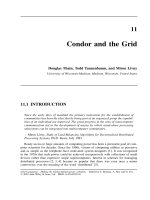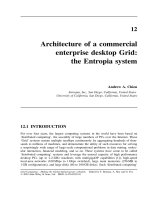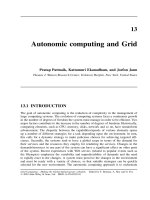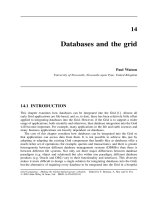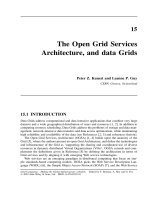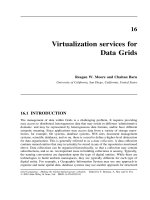Tài liệu Grid Computing P31 docx
Bạn đang xem bản rút gọn của tài liệu. Xem và tải ngay bản đầy đủ của tài liệu tại đây (227.8 KB, 18 trang )
31
DISCOVER: a computational
collaboratory for interactive
Grid applications
‡
Vijay Mann and Manish Parashar
∗,†
Rutgers, The State University of New Jersey, Piscataway, New Jersey, United States
31.1 INTRODUCTION
A collaboratory is defined as a place where scientists and researchers work together to
solve complex interdisciplinary problems, despite geographic and organizational bound-
aries [1]. The growth of the Internet and the advent of the computational ‘Grid’ [2, 3]
have made it possible to develop and deploy advanced computational collaboratories [4, 5]
that provide uniform (collaborative) access to computational resources, services, applica-
tions and/or data. These systems expand the resources available to researchers, enable
‡
The DISCOVER collaboratory can be accessed at />∗
National Science Foundation (CAREERS, NGS, ITR) ACI9984357, EIA0103674, EIA0120934
†
Department of Energy/California Institute of Technology (ASCI) PC 295251
Grid Computing – Making the Global Infrastructure a Reality. Edited by F. Berman, A. Hey and G. Fox
2003 John Wiley & Sons, Ltd ISBN: 0-470-85319-0
730
VIJAY MANN AND MANISH PARASHAR
multidisciplinary collaborations and problem solving, accelerate the dissemination of
knowledge, and increase the efficiency of research.
This chapter presents the design, implementation and deployment of the DISCOVER
computational collaboratory that enables interactive applications on the Grid. High-perfor-
mance simulations are playing an increasingly critical role in all areas of science and
engineering. As the complexity and computational cost of these simulations grows, it has
become important for scientists and engineers to be able to monitor the progress of these
simulations and to control or steer them at run time. The utility and cost-effectiveness of
these simulations can be greatly increased by transforming traditional batch simulations
into more interactive ones. Closing the loop between the user and the simulations enables
experts to drive the discovery process by observing intermediate results, by changing
parameters to lead the simulation to more interesting domains, play what-if games, detect
and correct unstable situations, and terminate uninteresting runs early. Furthermore, the
increased complexity and multidisciplinary nature of these simulations necessitates a col-
laborative effort among multiple, usually geographically distributed scientists/engineers.
As a result, collaboration-enabling tools are critical for transforming simulations into true
research modalities.
DISCOVER [6, 7] is a virtual, interactive computational collaboratory that enables
geographically distributed scientists and engineers to collaboratively monitor and control
high-performance parallel/distributed applications on the Grid. Its primary goal is to bring
Grid applications to the scientists/‘engineers’ desktop, enabling them to collaboratively
access, interrogate, interact with and steer these applications using Web-based portals.
DISCOVER is composed of three key components (see Figure 31.1):
1. DISCOVER middleware substrate, which enables global collaborative access to mul-
tiple, geographically distributed instances of the DISCOVER computational collabo-
ratory and provides interoperability between DISCOVER and external Grid services.
Collaboration
group
Mobile client
Application 2
Application 2
HTTP / SECURE HTTP / secure soc
kets
Chat,
Whiteboard,
Collaborative
Visualization…
Private key,
MD5, SSL
Distributed DISCOVER servers
CORBA / RMI / IIOP
Local & remote
databases
Interaction & steering
Authentication / security
Visualization
Master servlet
(RMI/sockets/HTTP)
Policy rule-base
Session archival
Database handler
Application interaction servlet
INTERACTION SERVER
Servlets
DIOS
API
DIOS interaction
agents
Interaction
enabled
computational
objects
Application 1
PDA
Collaboration
group
Application 1
Viz plot
Interaction and Collaboration Po
rtals
Mobile client
Figure 31.1 Architectural schematic of the DISCOVER computational collaboratory.
DISCOVER: A COMPUTATIONAL COLLABORATORY FOR INTERACTIVE GRID APPLICATIONS
731
The middleware substrate enables DISCOVER interaction and collaboration servers to
dynamically discover and connect to one another to form a peer network. This allows
clients connected to their local servers to have global access to all applications and
services across all servers based on their credentials, capabilities and privileges. The
DISCOVER middleware substrate and interaction and collaboration servers build on
existing Web servers and leverage commodity technologies and protocols to enable
rapid deployment, ubiquitous and pervasive access, and easy integration with third
party services.
2. Distributed Interactive Object Substrate (DIOS), which enables the run-time monitor-
ing, interaction and computational steering of parallel and distributed applications on
the Grid. DIOS enables application objects to be enhanced with sensors and actu-
ators so that they can be interrogated and controlled. Application objects may be
distributed (spanning many processors) and dynamic (be created, deleted, changed or
migrated at run time). A control network connects and manages the distributed sen-
sors and actuators, and enables their external discovery, interrogation, monitoring and
manipulation.
3. DISCOVER interaction and collaboration portal, which provides remote, collaborative
access to applications, application objects and Grid services. The portal provides a
replicated shared workspace architecture and integrates collaboration tools such as chat
and whiteboard. It also integrates ‘Collaboration Streams,’ that maintain a navigable
record of all client–client and client-application interactions and collaborations.
Using the DISCOVER computational collaboratory clients can connect to a local server
through the portal and can use it to discover and access active applications and services
on the Grid as long as they have appropriate privileges and capabilities. Furthermore, they
can form or join collaboration groups and can securely, consistently and collaboratively
interact with and steer applications based on their privileges and capabilities. DISCOVER
is currently operational and is being used to provide interaction capabilities to a number of
scientific and engineering applications, including oil reservoir simulations, computational
fluid dynamics, seismic modeling, and numerical relativity. Furthermore, the DISCOVER
middleware substrate provides interoperability between DISCOVER interaction and col-
laboration services and Globus [8] Grid services. The current DISCOVER server network
includes deployments at CSM, University of Texas at Austin, and is being expanded to
include CACR, California Institute of Technology.
The rest of the chapter is organized as follows. Section 31.2 presents the
DISCOVER middleware substrate. Section 31.3 describes the DIOS interactive object
framework. Section 31.3.4 presents the experimental evaluation. Section 31.4 describes
the DISCOVER collaborative portal. Section 31.5 presents a summary of the chapter and
the current status of DISCOVER.
31.2 THE DISCOVER MIDDLEWARE SUBSTRATE
FOR GRID-BASED COLLABORATORIES
The proliferation of the computational Grid and recent advances in Grid technologies
have enabled the development and deployment of a number of advanced problem-solving
732
VIJAY MANN AND MANISH PARASHAR
environments and computational collaboratories. These systems provide specialized ser-
vices to their user communities and/or address specific issues in wide-area resource sharing
and Grid computing [9]. However, solving real problems on the Grid requires combin-
ing these services in a seamless manner. For example, execution of an application on
the Grid requires security services to authenticate users and the application, information
services for resource discovery, resource management services for resource allocation,
data transfer services for staging, and scheduling services for application execution. Once
the application is executing on the Grid, interaction, steering and collaboration services
allow geographically distributed users to collectively monitor and control the application,
allowing the application to be a true research or instructional modality. Once the appli-
cation terminates data storage and cleanup, services come into play. Clearly, a seamless
integration and interoperability of these services is critical to enable global, collaborative,
multi-disciplinary and multi-institutional, problem solving.
Integrating these collaboratories and Grid services presents significant challenges. The
collaboratories have evolved in parallel with the Grid computing effort and have been
developed to meet unique requirements and support specific user communities. As a result,
these systems have customized architectures and implementations and build on specialized
enabling technologies. Furthermore, there are organizational constraints that may prevent
such interaction as it involves modifying existing software. A key challenge then is the
design and development of a robust and scalable middleware that addresses interoperabil-
ity and provides essential enabling services such as security and access control, discovery,
and interaction and collaboration management. Such a middleware should provide loose
coupling among systems to accommodate organizational constraints and an option to join
or leave this interaction at any time. It should define a minimal set of interfaces and
protocols to enable collaboratories to share resources, services, data and applications on
the Grid while being able to maintain their architectures and implementations of choice.
The DISCOVER middleware substrate [10, 11] defines interfaces and mechanisms for
a peer-to-peer integration and interoperability of services provided by domain-specific
collaboratories on the Grid. It currently enables interoperability between geographically
distributed instances of the DISCOVER collaboratory. Furthermore, it also integrates DIS-
COVER collaboratory services with the Grid services provided by the Globus Toolkit [8]
using the CORBA Commodity Grid (CORBA CoG) Kit [12, 13]. Clients can now use
the services provided by the CORBA CoG Kit to discover available resources on the
Grid, to allocate required resources and to run applications on these resources, and use
DISCOVER to connect to and collaboratively monitor, interact with, and steer the appli-
cations. The middleware substrate enables DISCOVER interaction and steering servers as
well as Globus servers to dynamically discover and connect to one another to form a peer
network. This allows clients connected to their local servers to have global access to all
applications and services across all the servers in the network based on their credentials,
capabilities and privileges.
31.2.1 DISCOVER middleware substrate design
The DISCOVER middleware substrate has a hybrid architecture, that is, it provides a
client-server architecture from the users’ point of view, while the middle tier has a
DISCOVER: A COMPUTATIONAL COLLABORATORY FOR INTERACTIVE GRID APPLICATIONS
733
peer-to-peer architecture. This approach provides several advantages. The middle-tier
peer-to-peer network distributes services across peer servers and reduces the require-
ments of a server. As clients connect to the middle tier using the client-server approach,
the number of peers in the system is significantly smaller than a pure peer-to-peer system.
The smaller number of peers allows the hybrid architecture to be more secure and better
managed as compared to a true peer-to-peer system and restricts the security and man-
ageability concerns to the middle tier. Furthermore, this approach makes no assumptions
about the capabilities of the clients or the bandwidth available to them and allows for
very thin clients. Finally, servers in this model can be lightweight, portable and easily
deployable and manageable, instead of being heavyweight (as in pure client-server sys-
tems). A server may be deployed anywhere there is a growing community of users, much
like a HTTP Proxy server.
A schematic overview of the overall architecture is presented in Figure 31.2(a). It
consists of (collaborative) client portals at the frontend, computational resources, ser-
vices or applications at the backend, and the network of peer servers in the middle. To
enable ubiquitous access, clients are kept as simple as possible. The responsibilities of
the middleware include providing a ‘repository of services’ view to the client, providing
controlled access to these backend services, interacting with peer servers and collectively
managing and coordinating collaboration. A client connects to its ‘closest’ server and
should have access to all (local and remote) backend services and applications defined by
its privileges and capabilities.
Backend services can divided into two main classes – (1) resource access and man-
agement toolkits (e.g. Globus, CORBA CoG) providing access to Grid services and
(2) collaboratory-specific services (e.g. high-performance applications, data archives and
network-monitoring tools). Services may be specific to a server or may form a pool of
services that can be accessed by any server. A service will be server specific if direct
access to the service is restricted to the local server, possibly due to security, scalabil-
ity or compatibility constraints. In either case, the servers and the backend services are
accessed using standard distributed object technologies such as CORBA/IIOP [14, 15]
and RMI [16]. XML-based protocols such as SOAP [17] have been designed considering
the services model and are ideal candidates.
Web client
(browser)
Web client
(browser)
Web / application
server
Web / application
server
Service
Service
Service
Service
Service
Service
Service
Pool of services
(name server, registry, etc.,)
CORBA/HOP
CORBA,
RMI,etc,
CORBA,
RMI,etc,
Web client Web client
HTTP HTTP
Serviets
Daemon servlet
Discover CorbaServer
Web client Web client
HTTP HTTP
Serviets
Daemon servlet
Discover CorbaServer
Application
proxy
CorbaProxy
CorbaProxyInterface
TCP SOCKETS / RMHIOP
Application
Application
proxy
CorbaProxy
CorbaProxyInterface
TCP SOCKETS / RMHIOP
Application
Figure 31.2 DISCOVER middleware substrate: (a) architecture and (b) implementation.
734
VIJAY MANN AND MANISH PARASHAR
The middleware architecture defines three levels of interfaces for each server in the
substrate. The level-one interfaces enable a server to authenticate with peer servers and
query them for active services and users. The level-two interfaces are used for authenti-
cating with and accessing a specific service at a server. The level-three interfaces (Grid
Infrastructure Interfaces) are used for communicating with underlying core Grid ser-
vices (e.g. security, resource access). The implementation and operation of the current
DISCOVER middleware substrate is briefly described below. Details can be found in
References [10, 18].
31.2.2 DISCOVER middleware substrate implementation
31.2.2.1 DISCOVER interaction and collaboration server
The DISCOVER interaction/collaboration servers build on commodity Web servers, and
extend their functionality (using Java Servlets [19]) to provide specialized services for
real-time application interaction and steering and for collaboration between client groups.
Clients are Java applets and communicate with the server over HTTP using a series of
HTTP GET and POST requests. Application-to-server communication either uses standard
distributed object protocols such as CORBA [14] and Java RMI [16] or a more opti-
mized, custom protocol over TCP sockets. An ApplicationProxy object is created for
each active application/service at the server and is given a unique identifier. This object
encapsulates the entire context for the application. Three communication channels are
established between a server and an application: (1) a MainChannel for application reg-
istration and periodic updates, (2) a CommandChannel for forwarding client interaction
requests to the application, and (3) a ResponseChannel for communicating application
responses to interaction requests. At the other end, clients differentiate between the var-
ious messages (i.e. Response, Error or Update) using Java’s reflection mechanism. Core
service handlers provided by each server include the Master Handler, Collaboration Han-
dler, Command Handler, Security/Authentication Handler and the Daemon Servlet that
listens for application connections. Details about the design and implementation of the
DISCOVER Interaction and Collaboration servers can be found in Reference [7].
31.2.2.2 DISCOVER middleware substrate
The current implementation of the DISCOVER middleware consists of multiple inde-
pendent collaboratory domains, each consisting of one or more DISCOVER servers,
applications/services connected to the server(s) and/or core Grid services. The middle-
ware substrate builds on CORBA/IIOP, which provides peer-to-peer connectivity between
servers within and across domains, while allowing them to maintain their individual
architectures and implementations. The implementation is illustrated in Figure 31.2(b). It
uses the level-one and level-two interfaces to construct a network of DISCOVER servers.
A third level of interfaces is used to integrate Globus Grid Services [8] via the CORBA
CoG [12, 13]. The different interfaces are described below.
DiscoverCorbaServer interface:TheDiscoverCorbaServer is the level-one interface and
represents a server in the system. This interface is implemented by each server and
DISCOVER: A COMPUTATIONAL COLLABORATORY FOR INTERACTIVE GRID APPLICATIONS
735
defines the methods for interacting with a server. This includes methods for authenti-
cating with the server, querying the server for active applications/services and obtaining
the list of users logged on to the server. A DiscoverCorbaServer object is maintained
by each server’s Daemon Servlet and publishes its availability using the CORBA trader
service. It also maintains a table of references to CorbaProxy objects for remote applica-
tions/services.
CorbaProxy interface:TheCorbaProxy interface is the level-two interface and represents
an active application (or service) at a server. This interface defines methods for accessing
and interacting with the application/service. The CorbaProxy object also binds itself to
the CORBA naming service using the application’s unique identifier as the name. This
allows the application/service to be discovered and remotely accessed from any server.
The DiscoverCorbaServer objects at servers that have clients interacting with a remote
application maintain a reference to the application’s CorbaProxy object.
Grid Infrastructure Interfaces: The level-three interfaces represent core Globus Grid
Services. These include: (1) the DiscoverGSI interface that enables the creation and
delegation of secure proxy objects using the Globus GSI Grid security service, (2) the
DiscoverMDS that provides access to the Globus MDS Grid information service using
Java Naming and Directory Interface (JNDI) [20] and enables users to securely connect
to and access MDS servers, (3) the DiscoverGRAM interface that provides access to the
Globus GRAM Grid resource management service and allows users to submit jobs on
remote hosts and to monitor and manage these jobs using the CORBA Event Service [21],
and (4) the DiscoverGASS interface that provides access to the Globus Access to Sec-
ondary Storage (GASS) Grid data access service and enables Grid applications to access
and store remote data.
31.2.3 DISCOVER middleware operation
This section briefly describes key operations of the DISCOVER middleware. Details can
be found in References [10, 18].
31.2.3.1 Security/authentication
The DISCOVER security model is based on the Globus GSI protocol and builds on the
CORBA Security Service. The GSI delegation model is used to create and delegate an
intermediary object (the CORBA GSI Server Object) between the client and the service.
The process consists of three steps: (1) client and server objects mutually authenticate
using the CORBA Security Service, (2) the client delegates the DiscoverGSI server object
to create a proxy object that has the authority to communicate with other GSI-enabled Grid
Services, and (3) the client can use this secure proxy object to invoke secure connections
to the services.
Each DISCOVER server supports a two-level access control for the collaboratory
services: the first level manages access to the server while the second level manages
access to a particular application. Applications are required to be registered with a server
and to provide a list of users and their access privileges (e.g. read-only, read-write). This
information is used to create access control lists (ACL) for each user-application pair.




